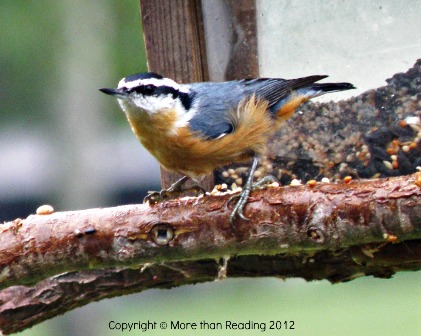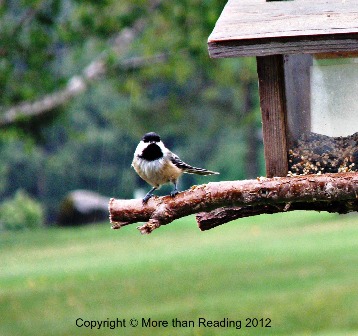Early Monday morning. Cool 10C. Cloudy. Dull. Grey. Intermittent light rain. Slow start today. Curl up on the living room couch. Sip vanilla hazelnut coffee. Gaze out the picture window at a small wood bird-feeder in the front garden. Framed by two dwarf Alberta spruce trees. Chickadee arrives. A black-capped chickadee – with ‘black cap, black bib and white cheeks’ (Peterson, p. 119).
Chickadee feeds. On niger seeds. And a mixture of other small seeds. Feeds again. Zings to a big, blue spruce tree nearby. Another small bird lands on the cedar perch.

Pecks at seeds. Red-orange breast feathers – some might say cinnamon. Blue-grey back and wing feathers. Black and white stripes at head.
New bird on the block! What is it?
Flies frantically fast over the roof of the house. Chickadee returns. Leaves immediately when the ‘new’ bird appears. Heirachy is established.
Reach for the bird books. In the old, black, barrister bookcase – handed down through the family. Part of our large home library. Organised. Know exactly where to look. Second shelf from the top. Next to wood heat, wilderness and trees. Open the bird book. Look for the name of the ‘new’ bird. In the chickadee family? Wren family? Finch family? Search the index.
Reminds me of classroom life. Searching for information about Harry’s frog. A green frog. Children observing and describing the frog. Sharing what they know. Getting frog books from the frog ‘basket of books’. Thinking aloud and demonstrating ‘finding information’. Going to the index. Looking up names. Green frogs. Tree frogs. White-lipped green tree frog. That could be it. Turning to p.25. Reading headings. Finding out…
Do the same with the bird book. Search the index. Look up names. Examine colourplates and written descriptions. A nuthatch?
A nuthatch is a ‘small, chubby tree-climber, with a long bill and a stubby tail’ (Peterson, p. 120). Is that a long bill? The bird nudges the small seeds around with his pointy beak as if he’s searching for a particular seed. Many seeds drop to the green grass below.
More information. Reddish breast. ‘Black line through eye’ (Peterson, Plate 44). Definitely a black stripe through his eye. Is that it? A red-breasted nuthatch?
This nuthatch is skittish. He pecks and quickly turns his head from side to side. Constantly looking round… for enemies, I suppose. Blue Jays? Red-tailed hawks? Humans?
In the next half hour, we see two black-capped chickadees and the red-breasted nuthatch taking turns at the bird-feeder. Two small, brown sparrows also come and go. We take photos – but the birds are fast! Chickadees peck, peck, peck and flit, flap, fly fast to the protection of the big, blue spruce. Hide in the thick, prickly boughs. Sparrows quickly disappear over the house roof. Nuthatch returns. Eats.

A rare moment. Nuthatch and chickadee are at the feeder at the same time. Nuthatch eats with his tail in the air. Chickadee hides at the side.
My favourite part in learning about a bird is to look at the illustration and immediately check for similarities on the real bird out the window. It’s like a puzzle. Find a clue. Does it fit? Double check. I love this way of learning – reminds me of classroom life. I’ll know this bird forever…
Peterson, R.T. (1947). A Field Guide to the Birds: eastern land and water birds. Boston: Houghton Mifflin Company.


Comments on: "A new bird on the block…reminds me of classroom life" (3)
Wonderful post! The Black-Capped Chickadee always bring a smile to my face when they visit our feeder. They’re very loud for such tiny critters.
Hi Jill,
Thanks for your comments. Yes, the chickadees are loud!
I like the way they are so friendly – and often stay on the feeder as we walk past.
Coral
That’s true, they certainly aren’t shy like the Cardinal. I was going to mention that but I didn’t want to ramble too long. 🙂 Enjoy them!